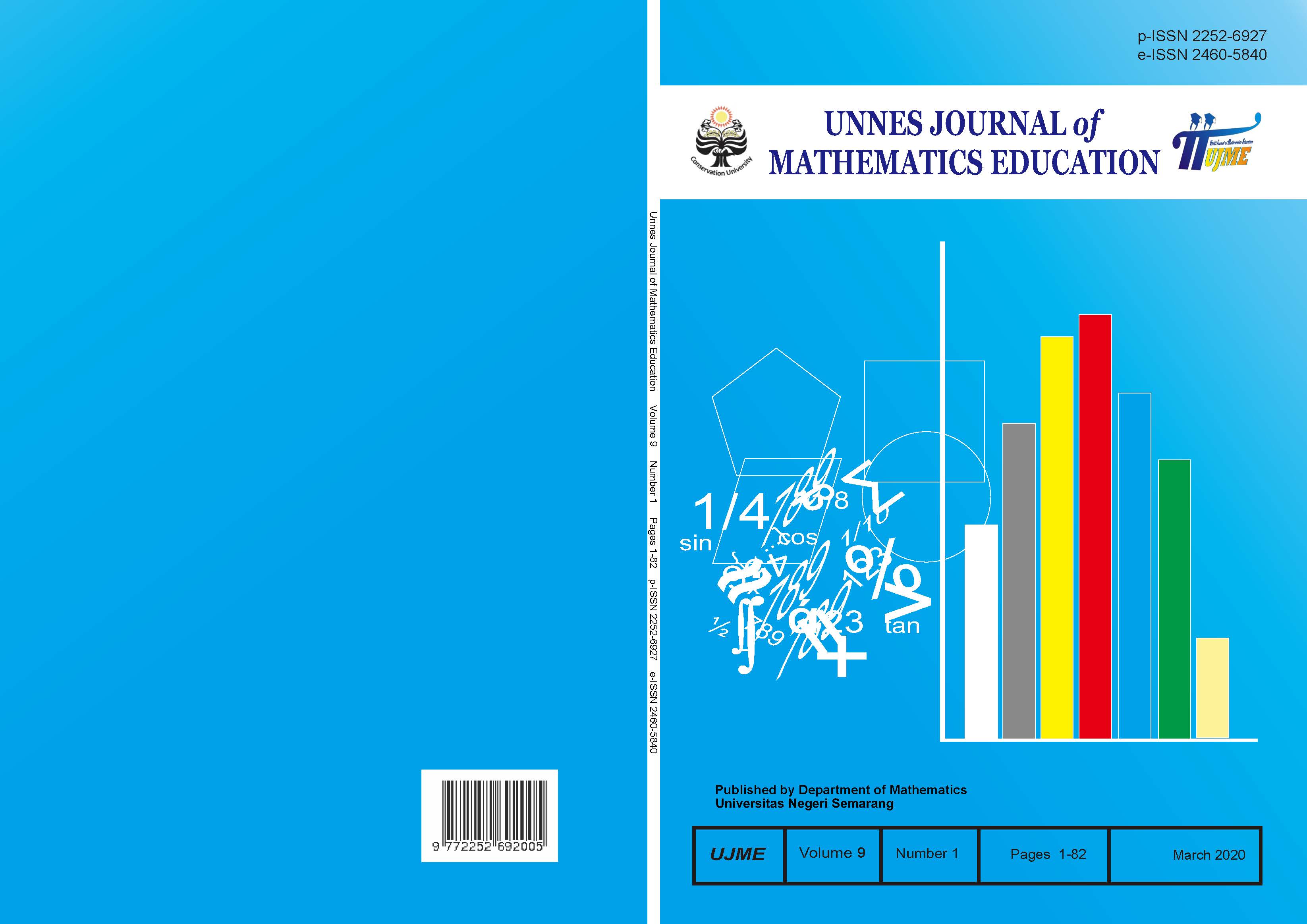Student’s mathematical connection reviewed from learning motivation in Advance Organizer Learning assisted by Schoology
##plugins.themes.academic_pro.article.main##
Abstract
Abstract
The research aims to determine if advanced Organizer learning is effective with the ability of the student’s mathematical connection and describing the mathematical connection ability of students reviewed from the motivation to learn at Advanced Organizer Learning Assisted schoology. The research method used is mixed method with sequential explanatory design. The research population is class IX Junior High School 33 Semarang, while the sample is IX C class as the research class. Samples were taken using the random sampling cluster technique. Subjects of the study were taken using purposive sampling techniques, so obtained six research subjects were selected based on the category of motivational learning. Methods of collecting data using observations, tests, polls, and interviews. The results showed that (1) the proportion of the students ' mathematical connection ability to the study of Schoology advanced Organizer is achieving the classical, average mathematical connection ability of students in Advance Organizer learning With the help of schoology reaching the Minimum Submission Criteria (MSC), and the mathematical connection ability of students after receiving Advance Organizer learningassisted schoology increased by 0.8. The results showed that Advance Organizer learning assisted schoology effectively on the ability of student mathematical connection. (2) Subjects with high learning motivation tend to meet all mathematical connection indicators. Subjects with motivational learning are likely to meet two of the three mathematical connection indicators. Subjects with low learning motivation tend to meet one of three mathematical connection indicators.
##plugins.themes.academic_pro.article.details##
References
Azmi, A. L., Wardono, & Cahyono, A. N. (2018). Mathematics Literacy on Creative Problem Solving with Realistic Mathematics Education Approach Assisted by Elearning Schoology. Unnes Journal of Mathematics Education, 7(1), 188-194.
Cresswel, J. W. (2016). Research Design Pendekatan Kualitatif, Kuantitatif, dan Mixed. Yogyakarta: Pustaka Pelajar.
Dharma, I. D. P. P. W., Pujiastuti, E., & Harianja, M. (2019). Penerapan Model Pembelajaran TPS (Think-Pair-Share) Untuk Meningkatkan Kemampuan Komunikasi Matematis dan Percaya Diri Peserta Didik Kelas X Mipa 1 SMA Negeri 6 Semarang Pada Materi Sistem Persamaan Linear Tiga Variabel Tahun Pelajaran 2018/2019. PRISMA, Prosiding Seminar Nasional Matematika 2, 239-246. Diakses dari https://journal.unnes.ac.id/sju/index.php/prisma/
Durksen, T. L., Way, J., Bobis, J., Anderson, J., Abilitying, K., & Martin, A. (2017). Motivation and Engagement in Mathematics: A Qualitative Framework for Teacher-Student. Mathematics Education Research Journal, 29(2), 163-181. Doi: https://doi.org/10.1007/s13394-017-0199-1
Fadhilla, W. R., Safaatullah, M. F., & Walid. (2019). Kemampuan Koneksi Matematis dan Kemampuan Berpikir Geometri melalui Modifikasi Pembelajaran Circuit Learning-Scaffolding. PRISMA, Prosiding Seminar Nasional Matematika 2, 132-138. Diakses dari https://journal.unnes.ac.id/sju/index.php/prisma/
Mulyaningsih, I. E. (2014). Pengaruh Interaksi Sosial Keluarga, Motivasi Belajar, dan Kemandirian Belajar Terhadap Prestasi Belajar. Jurnal Pendidikan dan Kebudayaan, 20(4), 441-451.
National Council of Teachers of Mathematics. (2000). Principles Standards and for School Mathematics. Reston, VA: NCTM.
Ni, L. B., Rohadi, N. S. B., & Alfana, H. B. (2016). Advance Organizer: Cognitive Instructional Strategy. International Journal of Computer Networks and Wireless Communications, 6(2), 53-57.
Prasetyo, A., Dwidayati, N. K., & Junaedi, I. (2017). Kemampuan Koneksi dan Disposisi Matematis Siswa Ditinjau dari Tipe Kepribadian Keirsey pada Pembelajaran Matematika Model Eliciting Activities. Unnes Journal of Mathematics Edication, 6(2), 190-197.
Prastiwi, I., Soedjoko, E., & Mulyono. (2014). Efektivitas Pembelajaran Conceptual Understanding Procedures untuk Meningkatkan Kemampuan Siswa pada Aspek Koneksi Matematika. Jurnal Kreano, 5(1), 41-47.
Pujiastuti, E., Mulyono, & Soedjoko, E. (2018). Pengungkapan Koneksi Matematis Sebagai Sarana Penelusuran Kemampuan dan Proses Memecahkan Masalah Peserta Didik. PRISMA, Prosiding Seminar Nasional Matematika 1, 618-627. Diakses dari https://journal.unnes.ac.id/sju/index.php/prisma/
Putri, R. I. & Santosa, R. H. (2015). Keefektifan Strategi REACT Ditinjau dari Prestasi Belajar, Kemampuan Penyelesaian Masalah, Koneksi Matematis, Self Efficacy. Jurnal Riset Pendidikan Matematika, 2(2), 262 – 272.
Rahmawati, Y. & Rachmawati, H. (2015). Model Pembelajaan Advance Organizer dengan Pendekatan Saintifik untuk Meningkatkan Kemampuan Koneksi Matematis. National Seminar of Mathematics and Mathematics Education Universitas Negeri Yogyakarta.
Sopyyev, Y., Winarti, E. R., & Agoestanto, A. (2013). Implementasi Pembelajaran Think Pair Share pada Materi Fungsi Ditinjau dari Motivasi Belajar. Unnes Journal of Mathematics Education, 2(2), 64-70.
Sugiyono. (2016). Metode Penelitian Pendidikan (Pendekatan Kuantitatif, Kualitatif, dan R&D). Bandung: Alfabeta.
Sumarni. (2016). Tinjauan Korelasi Antara Kemampuan Koneksi Matematis dan Self-Regulated Learning Matematika Siswa yang Pembelajarannya Melalui Learning Cycle 5E. JES-MAT, 2(1), 83-98.
Winarti, E. R., Haryanti, M. D., & Asih, T. S. N. (2019). Students’ Problem Solving Ability in Thinking Aloud Pair Problem Solving Learning Assisted by Schoology Viewed from Mathematical Disposition. Unnes Journal of Mathematics Education, 8(1), 14-18.
